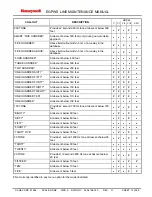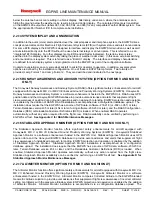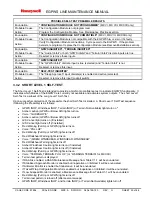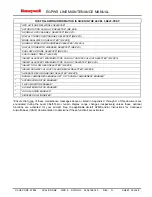
EGPWS LINE MAINTENANCE MANUAL
CAGE CODE: 97896
SCALE: NONE SIZE: A
DWG NO.: 060-4199-180
REV: G
SHEET 26 of 68
Installations that do not have the windshear function or the function enabled will not enunciate the windshear
message and illuminate windshear alert lights. Similarly, installations without the Terrain Alerting and Display (TAD)
function enabled will not have terrain lights and display or “TERRAIN” aural enunciation.
•
NOTE: The general sequence of the LEVEL 1 SELF-TEST is the same for all installations. The actual
aural message and nomenclature of the Alert/warning lamps will vary.
•
NOTE: Ensure that none of the RAAS maintenance messages or RAAS On-Ground (display) status messages
listed in Appendix C of this document is enunciated during the Level 1 Self-Test or terrain display range
changes (respectively) unless RAAS is activated for your aircraft. See the applicable aircraft AFMS and/or
Instructions for Continued Airworthiness (ICAW) documentation to determine if RAAS is activated.
•
NOTE: An enunciation of “GPS NOT NAVIGATING” during the Level 1 Self-Test indicates that the Internal P-
xPress GPS engine has not acquired sufficient satellites to navigate. If this message is enunciated, ensure the
aircraft is in full view of the constellation for at least 20 minutes. If this does not resolve the enunciation, verify
all interfaces of the coax cable from the antenna to the EGPWC.
3.3.3 LONG LEVEL 1 SELF-TEST
The Long Level 1 Self-Test is initiated by pressing and holding Self-Test until Self-Test voices start. The Long Level
1 Self-Test enunciates all configured and activated alert voices, including warning voices, caution voices, and
altitude callout voices immediately following the Short Level 1 Self-Test sequence above.
3.4 LEVEL 2 SELF-TEST - CURRENT FAULTS
Level 2 Self-Test provides enunciation of all faults existing at the time of the test request. Level 2 Self-Test is
initiated by pressing Self-Test within 3 seconds of the end of Level 1 Self-Test or following a
short cancel
during
Level 1 Self-Test.
If a fault is detected, it will be classified as either an internal or an external fault. Internal faults are defined as those
faults that originate within the EGPWC. Internal faults will turn on the red “COMPUTER FAIL” LED on the EGPWC
front panel. External faults are defined as those faults that originate from sources outside the EGPWC. External
faults will turn on the amber “EXTERNAL FAULT” LED on the EGPWC front panel.
Note that for the EGPWS/GNSSU (-060 MK V/VII), both internal and external fault lights will be lit if there is a
problem with the integral GNSSU subsystem.
If the EGPWC is connected to a GPS or GNSSU for position information (internal or external), various navigation
data status messages may also be listed during Level 2 Self Test. These messages indicate that there is a problem
with the position data, caused by antenna problems, satellite visibility or multi-path errors.
*Useful Tip #2
– Pressing the GPWS test switch for more than 2 seconds during Level 2 through 5 will bypass the
test information and will immediately jump to the end of that level (“PRESS TO CONTINUE” voice). GPWS INOP,
Windshear INOP, and Terrain INOP (or Terrain Not Available) lights are turned on (or remain on) for the duration of
the Level 2 Self-Test.







































